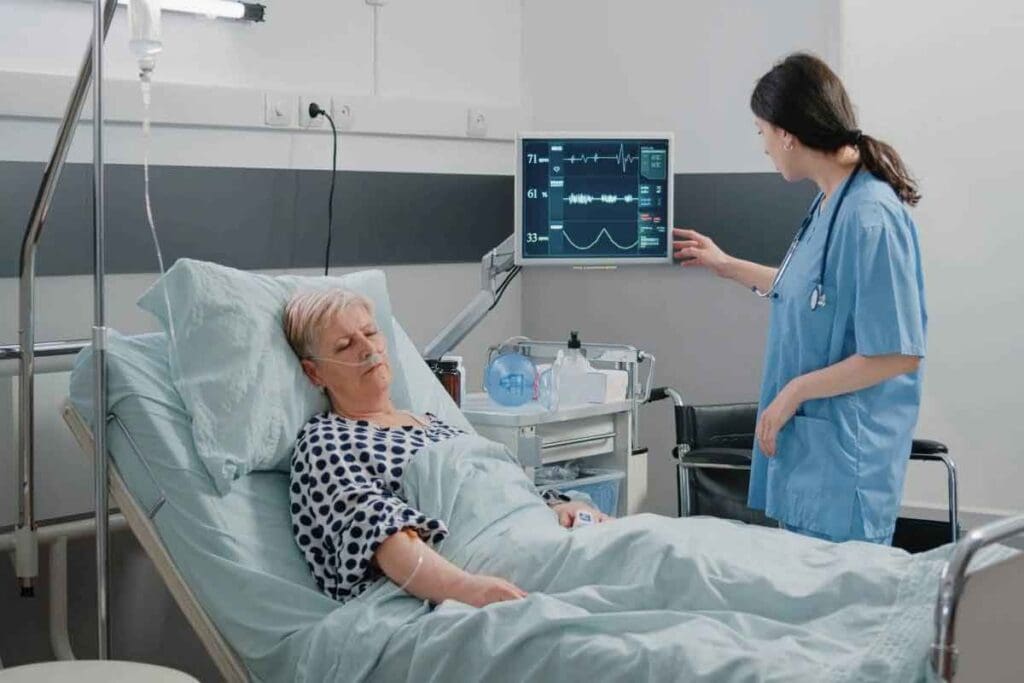Last Updated on November 20, 2025 by Ugurkan Demir

Acute chest syndrome (ACS) is a serious and potentially deadly problem for people with sickle cell disease. It affects up to 50 percent of those with the condition at some point.
Chest pain and breathing issues in sickle cell disease might mean ACS, a medical emergency. Liv Hospital offers international expertise and patient-focused care. They help understand the critical criteria, symptoms, and treatments for this serious issue. The National Center for Biotechnology Information says ACS is marked by new lung problems on chest scans, chest pain, and other breathing symptoms.

Acute Chest Syndrome is a big problem for people with Sickle Cell Disease. It causes new lung problems and can lead to serious issues. Learning how to manage it is key to helping patients.
Acute Chest Syndrome (ACS) is when a new lung issue shows up on an X-ray. It can cause chest pain, fever, and trouble breathing. It’s a big problem for Sickle Cell Disease patients, affecting up to 50% of them.
ACS happens more often in certain types of Sickle Cell Disease. Knowing this helps doctors plan better care.
ACS is a major cause of illness and death in SCD patients. It can lead to serious lung problems and even death. Many patients need to go to the hospital and get intensive care.
ACS is very deadly, causing up to 25% of SCD deaths. How well a patient does depends on how bad the episode is, how fast they get treated, and their overall health.
Key factors influencing ACS outcomes:
Spotting ACS early is key to better care and outcomes. Quick diagnosis and treatment can save lives. Doctors need to watch for signs of ACS, mainly in patients at high risk.
Teaching patients and their families about ACS symptoms is also important. Knowing the signs and acting fast can help reduce the harm ACS can cause.

Understanding ACS symptoms is key to early diagnosis and treatment in SCD patients. The symptoms can vary and differ in severity.
ACS patients often show a mix of symptoms, including chest pain, fever, cough, and shortness of breath. These symptoms are often seen with new lung issues on chest scans, a key sign of ACS.
A study showed how common these symptoms are, as seen in the table below:
| Symptom | Prevalence (%) |
| Chest Pain | 65 |
| Fever | 60 |
| Cough | 45 |
| Shortness of Breath | 55 |
ACS symptoms can quickly get worse, with some patients facing severe breathing problems suddenly. A clinical expert noted:
“The timeline of symptom progression in ACS can vary, but often, patients report a worsening of symptoms over 24 to 48 hours.”
ACS symptoms can differ by age. Younger patients might show fewer symptoms at first. Older patients might have more severe symptoms due to more organ damage.
A study found big differences in how ACS symptoms show up in different age groups. It highlighted the severity and how symptoms progress.
Acute chest syndrome is a serious issue for people with sickle cell disease. It’s diagnosed by looking at symptoms and imaging results. These signs help doctors figure out if someone has ACS.
A new pulmonary infiltrate seen on chest scans is key to diagnosing ACS. Doctors use chest X-rays or CT scans to spot this. It shows the lungs might be affected.
Chest pain is a common symptom of ACS. The pain can feel different and get worse when you breathe deeply or cough. It’s important to tell if it’s from ACS or something else.
Fever is a big sign, with temperatures over 38.5°C pointing to infection or inflammation. Keeping an eye on the body’s temperature helps doctors see how bad ACS is.
Tachypnea, or fast breathing, and respiratory distress are big warning signs of ACS. These show the patient is having trouble breathing. It’s important to act fast to avoid more problems.
The other five criteria include hypoxemia, cough, wheezing, rales or crackles, and a recent respiratory infection. Together with the first criterion, they help doctors make an accurate diagnosis of ACS.
ACS in Sickle Cell Disease involves many factors. It mainly happens when small pulmonary vessels get blocked by sickled red blood cells. This can be caused by infections, fat embolisms, and other reasons.
Vaso-occlusive crises are key in Sickle Cell Disease. Sickled red blood cells stick together and block small lung vessels. This leads to vascular obstruction, inflammation, and lung damage.
Fat embolism syndrome is another major factor in ACS. It happens when fat globules enter the blood and block lung vessels. This causes mechanical blockage and an inflammatory response, harming lung function.
Infections often trigger ACS. They make sickling worse due to low oxygen and acid. This makes the vaso-occlusive process worse and hurts lung function. Knowing how infections affect ACS is key to better treatments.
Pulmonary infarction is a serious issue that can cause ACS. It happens when vessels in the lungs get blocked. This damages lung tissue and increases the risk of death.
Understanding these mechanisms is vital for managing ACS in Sickle Cell Disease. Healthcare providers can then create better treatments to help patients.
Acute Chest Syndrome risk factors in Sickle Cell Disease patients include demographic, genetic, and environmental triggers. Knowing these factors helps identify high-risk patients and prevent the syndrome.
Age is a big factor in ACS risk. Children under 4 face a higher risk due to their young immune systems and fetal hemoglobin. Adults with SCD are also at risk, mainly those with a history of ACS.
Genetic factors and hemoglobin phenotypes greatly increase ACS risk. For example, those with HbSS or HbSβ thalassemia are at higher risk than those with HbSC or HbSβ thalassemia. Specific genetic modifiers can also affect risk.
Environmental factors like cold weather, high altitude, and pollutants can trigger ACS. Respiratory infections are also a big risk, more so in certain seasons. Knowing these triggers helps in preventing ACS.
Patients with SCD face a higher risk of ACS after surgery, mainly after major surgeries or those under general anesthesia. Close monitoring and proper care before and after surgery can reduce this risk.
In summary, understanding and identifying ACS risk factors is key to managing and preventing this serious complication in Sickle Cell Disease patients.
Diagnosing acute chest syndrome (ACS) in patients with sickle cell disease is complex. It involves clinical evaluation, imaging studies, lab tests, and microbiological investigations. These steps help identify ACS and rule out other conditions.
Imaging is key in diagnosing ACS. Chest radiography is used to spot new lung issues, a sign of ACS. Sometimes, computed tomography (CT) scans are used to check lung damage or other problems.
Laboratory tests are vital for checking ACS severity and patient health. Important tests include:
Finding the cause of ACS is key for treatment. Tests like blood cultures and sputum cultures help find infections.
ACS can look like other lung problems, making it important to rule out other conditions. These include pneumonia, pulmonary embolism, and asthma attacks. A detailed diagnostic process helps tell ACS apart from these conditions.
| Diagnostic Tool | Purpose | Key Findings |
| Chest Radiography | Identify new pulmonary infiltrates | New infiltrates indicative of ACS |
| Arterial Blood Gas (ABG) | Assess oxygenation status | Hypoxemia |
| Blood Cultures | Detect bacteremia | Positive cultures indicating infection |
Managing Acute Chest Syndrome (ACS) in Sickle Cell Disease needs a detailed plan. The main goals are to ease symptoms, boost oxygen levels, and stop more problems.
Supportive care is key in handling ACS. This includes:
Early action with these steps can greatly help patients.
Oxygen therapy is vital in ACS treatment. It helps increase oxygen levels and lessen symptoms. Supplemental oxygen should follow set rules.
Pain control is essential in ACS treatment. Opioids are often used for severe pain, along with other pain relievers. The aim is to manage pain well without too many side effects.
Blood transfusions are important in ACS management. They help improve oxygen delivery to tissues. Simple or exchange transfusions might be used, based on the patient’s condition and blood level.
Choosing to transfuse should be based on careful thought and set rules.
People with sickle cell disease need a full plan to stop chest episodes from coming back. It’s key to keep these episodes away to make life better for them.
Hydroxyurea is a big help in stopping chest episodes from happening again. It makes more fetal hemoglobin, which lowers the chance of these episodes. Research shows it cuts down on ACS, making things better for patients.
Hydroxyurea does more than just help with chest episodes. It also makes painful crises less common and might cut down on blood transfusions.
Vaccines are very important in stopping infections that can cause ACS. Pneumococcal conjugate vaccine and influenza vaccine are key for sickle cell disease patients. Keeping up with vaccines can lower the chance of getting sick and having ACS.
Doctors should make sure patients get all the vaccines they need, following the latest advice.
Incentive spirometry is a simple way to help patients breathe deeply. It helps avoid lung problems. Using it, even during pain or after surgery, can lower ACS risk.
Changing how you live is key to managing sickle cell disease and avoiding ACS. Patients should avoid smoking, eat right, and drink plenty of water. Regular check-ups with doctors are also important to keep track of the disease and adjust treatment plans.
Teaching patients about the early signs of ACS and when to get help is vital. This way, they can act fast if they start to feel bad.
New insights into Acute Chest Syndrome have led to new ways to manage Sickle Cell Disease. Researchers are working on targeted treatments and better diagnostic tools. These efforts aim to fight this serious complication.
New treatments for Acute Chest Syndrome are being tested. These include anti-inflammatory agents and endothelin receptor antagonists. They aim to tackle the inflammation and blockages in blood vessels.
A study found that anti-inflammatory therapy can help lessen ACS episodes.
“The integration of novel therapeutic agents into treatment protocols represents a significant advancement in the care of patients with Sickle Cell Disease.”
Finding reliable biomarkers for ACS early detection is key. New research points to inflammatory markers and genetic indicators as possible predictors. This could lead to early treatment.
Genetic therapies could change the course of Sickle Cell Disease. They might even lower the risk of ACS. Gene editing technologies and gene therapy approaches are being studied for their treatment possibilities.
Thanks to data analytics and machine learning, better ACS prediction models have been developed. These models use clinical data, genetic info, and environmental factors. They help predict when ACS might happen, allowing for early action.
As research keeps moving forward, these new methods will likely improve how we manage Acute Chest Syndrome. This will help patients with Sickle Cell Disease get better care and outcomes.
Acute Chest Syndrome (ACS) in Sickle Cell Disease is a big problem. It causes a lot of sickness and death. We need to keep working on how to treat it better.
Spotting ACS early and treating it fast is key. This helps avoid serious problems. Knowing how to diagnose and treat ACS is very important.
There are many ways to help patients with ACS. These include using oxygen, managing pain, and giving blood transfusions. Preventing ACS from happening again is also important.
Using treatments like hydroxyurea and getting vaccines can help. Incentive spirometry is another tool. These methods can make a big difference.
Healthcare providers can do better for their patients by understanding ACS. They need to know how it works and how to diagnose it. This knowledge helps improve care.
Research is ongoing to find new ways to treat ACS. New treatments and tests are being developed. This will help manage ACS in sickle cell disease better.
Acute Chest Syndrome is a serious problem in sickle cell disease. It shows up as a new spot on a chest X-ray. It also includes chest pain, fever, and trouble breathing.
Symptoms include chest pain, fever, cough, and trouble breathing. Younger patients might not show these symptoms as clearly.
Doctors use symptoms, chest X-rays, and blood tests to diagnose it. These tests help confirm the diagnosis.
The main signs are a new spot on a chest X-ray, chest pain, fever, and trouble breathing. These signs help doctors diagnose ACS.
ACS happens due to several reasons. These include blockages in blood vessels, fat in the blood, infections, and lung damage. All these factors play a role in ACS.
Younger age and certain blood types increase the risk. Environmental factors and surgery can also trigger ACS.
Treatment includes oxygen, pain relief, and blood transfusions. The goal is to manage symptoms and prevent further problems.
While prevention is not complete, some steps can help. These include hydroxyurea, vaccines, breathing exercises, and healthy living.
New research includes better treatments and early detection tools. Genetic therapies and improved prediction models are also being explored.
Antibiotics fight infections that can cause ACS. The right antibiotic depends on the infection type.
ACS is a major cause of illness and death in sickle cell disease. It leads to serious complications and increases the risk of death.
Subscribe to our e-newsletter to stay informed about the latest innovations in the world of health and exclusive offers!